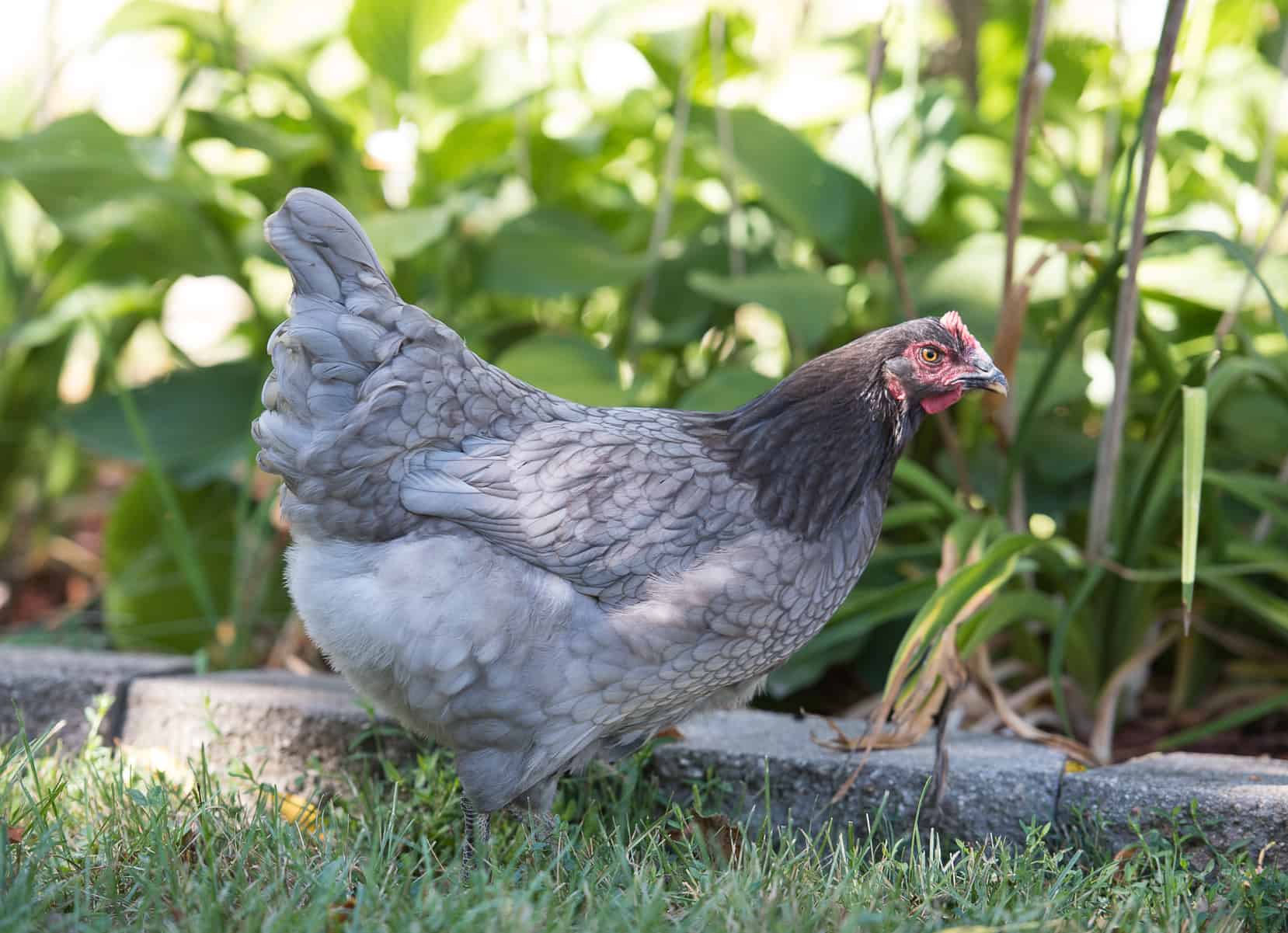Sapphire Gem chickens are an exciting addition to the world of poultry, known for their unique and eye-catching appearance. Developed in the Czech Republic, these birds are a hybrid variety, combining traits from both heritage and hybrid chickens, making them a versatile and appealing option for backyard chicken enthusiasts. The intriguing mix of lavender and blue feathers sets the Sapphire Gem apart from other breeds, giving them a distinct and alluring presence in any flock.
This distinctive bird is the result of a cross between a Blue Plymouth Rock and a Barred Plymouth Rock, contributing to its exceptional qualities. These chickens are not only prized for their appealing plumage but also for their ability to lay large, brown eggs, making them a popular choice for those seeking both aesthetics and productivity. One interesting feature of Sapphire Gems is their sex-linked status, which allows for easy identification of the bird’s gender based on their feather coloration.
When it comes to personality, Sapphire Gem chickens tend to exhibit a friendly and gentle temperament that makes them suitable for those new to raising chickens. Their foraging skills make them an excellent choice for owners seeking lower maintenance chickens, capable of finding their own food if allowed to free-range. Overall, the Sapphire Gem chicken’s unique features and versatile nature make it a value-adding addition to any flock.
Origins of the Sapphire Gem Chicken
Historical Background
The Sapphire Gem chicken is an intriguing breed known for its stunning appearance and delightful personality. This captivating bird originated from the result of a cross between a Blue Plymouth Rock and a Barred Plymouth Rock. The breed has a close relationship with the Old Andalusians, a heritage breed that dates back to the mid-1800s.
Geographic Origin
The Sapphire Gem chicken has its roots in the Czech Republic. This extraordinary bird quickly gained popularity among poultry enthusiasts due to its unique combination of gray-blue feathers and brilliant red combs.
Despite being often confused with other Sapphire chickens or the Sapphire Olive Egger, the Sapphire Gem is distinct for its ability to lay large-sized, brown eggs. A prolific layer, a Sapphire Gem hen can lay up to 290 eggs per year.
Breed Characteristics
Physical Appearance
The Sapphire Gem chicken, also known as the Blue Plymouth Rock, is a captivating breed with a stunning appearance. They exhibit an elegant mix of gray-blue feathers and brilliant red combs, resembling a beautiful sapphire gem. These birds are versatile and hardy, making them ideal for backyard flock owners looking for both attractive appearance and practical benefits. In terms of size, Sapphire Gems are medium to large birds, with hens typically weighing around 5 to 7 pounds.
Temperament
Sapphire Gem chickens are known for their delightful personalities. They are generally friendly and easy to handle, making them an excellent choice for families and first-time chicken keepers. These birds are also not known for being broody, which is a desirable trait for flock owners who prioritize reliable egg production.
Color Varieties
Although Sapphire Gem chickens are mostly recognized for their gray-blue feathers, it’s important to note that they do not breed true1. This means that the offspring of two Sapphire Gem chickens may exhibit a variety of different colors and patterns. Despite the potential for color variations, their distinctive appearance and exceptional egg-laying capabilities make them a popular choice among poultry enthusiasts.
Cultural Significance
Symbolism
The Sapphire Gem chicken, created by crossing a Blue Plymouth Rock and a Barred Plymouth Rock, embodies a unique appearance that holds special meaning for some people. Its striking blueish-gray plumage represents elegance and rarity in the poultry world. These birds have a calm and friendly nature, making them a symbol of peace and harmony. They also display a vigilant attitude when it comes to predators, showcasing their protective instincts in a flock. Though not deeply steeped in cultural symbolism, Sapphire Gem chickens’ distinctive appearance and qualities help to create positive associations.
Popularity
Sapphire Gem chickens have gained significant popularity among chicken enthusiasts since their introduction. Their striking plumage is one of the main reasons for their increased demand. The combination of their friendly temperament and excellent egg-laying abilities make them ideal backyard chickens for beginners and experienced poultry keepers alike.
Their popularity extends beyond their physical attributes. The Sapphire Gem chicken’s productive characteristics also contribute to their appeal. They are known to lay around 250 eggs per year, providing a sustainable source of fresh eggs for their owners. As a relatively new breed, there’s a growing online community of Sapphire Gem chicken keepers, eager to share experiences and provide support.
In conclusion, the Sapphire Gem chicken’s cultural significance stems from its exceptional beauty, symbolism, and rapidly growing popularity among backyard poultry enthusiasts.
Raising Sapphire Gem Chickens
Habitat Requirements
Sapphire Gem Chickens are generally easy to raise, but they have specific habitat requirements to thrive. They need a spacious and well-ventilated coop, providing at least 2-3 square feet of space per bird. Proper ventilation is essential in preventing respiratory issues and ensuring a healthy living environment. Ensure that both indoor roosting and outdoor run spaces are predator-proof to keep your chickens safe.
These chickens prefer perches to roost on, and you should provide one perch for every 4-5 birds, with about 8 to 10 inches of space between each bird. In addition, provide nest boxes for laying eggs; an ideal ratio is one nest box for every 3-4 hens.
Feeding and Nutrition
Sapphire Gem Chickens require a balanced diet for optimal growth and egg production. Offer them a high-quality chicken feed containing 16-18% protein, along with calcium and other essential vitamins and minerals. You can provide a grit to aid in proper digestion.
When they are around 18 weeks old, gradually transition the hens to a layer feed containing 16% protein and 3-4% calcium to support strong eggshells.
Include healthy treats, such as vegetables, fruits, and grains, but avoid feeding them harmful foods like chocolate, avocado, or excessively salty treats. Ensure they have access to clean, fresh water at all times.
- Starter feed: 20-22% protein, first 6 weeks
- Grower feed: 16-18% protein, from 6 weeks until they start laying eggs
- Layer feed: 16% protein, 3-4% calcium, 18 weeks onward
Health and Wellness
Sapphire Gem Chickens are generally robust and healthy birds, but regular care and maintenance can minimize the risk of illnesses. Perform bi-weekly inspections to check for signs of illness, such as lethargy, difficulty breathing, or unusual behavior.
Practice proper coop maintenance, including regular cleaning and ventilation, to reduce the risk of respiratory infections and parasites. External parasites, like mites and lice, can be controlled with dust baths and periodic inspection.
Make sure to monitor your flock’s overall condition and consult a veterinarian if any health issues arise. With appropriate care, Sapphire Gem Chickens can thrive and provide eggs for years to come.
Breeding Practices
Selective Breeding
The Sapphire Gem Chicken is a unique breed with a beautiful appearance. To maintain their desirable traits, breeders must engage in careful selective breeding practices. This involves choosing chickens that display the desired characteristics, such as vibrant blue plumage and fibromelanosis gene, and breeding them together. Doing so helps ensure that these traits are passed down to the next generation.
When selecting chickens for breeding, breeders should consider factors such as:
- Color: Look for chickens with strong shades of lavender and blue throughout their feathers.
- Egg production: Sapphire Gems are known for their high egg production, so select hens that consistently lay a large number of eggs.
- Temperament: As these chickens are known for their friendly personalities, choose those that exhibit a calm and sociable demeanor.
Genetics of Coloring
The fascinating colors of Sapphire Gem Chickens are determined by their genetics, specifically the presence of the fibromelanosis gene. This gene is responsible for the unique appearance of the vibrant blue feathers found in these birds.
To preserve the Sapphire Gem coloring, breeders should focus on pairing chickens that carry this gene. However, it’s important to note that the offspring may still display a range of colors, including blue splash and white spotted variations.
By adhering to these selective breeding practices and focusing on the genetics of coloring, breeders can continue to produce stunning Sapphire Gem Chickens for generations to come.
Economic Impact
Market Value
The Sapphire Gem Chicken is a relatively new and rare breed, known for its unique appearance and high egg production. Due to their rarity and novelty, Sapphire Gems can be more expensive than other common breeds, impacting their market value. The increased demand for this breed among chicken hobbyists and fanciers not only raises the prices but also fosters a market for specialty breeders and suppliers.
Contribution to Poultry Industry
Known for their consistent and substantial egg production, Sapphire Gems are great contributors to the poultry industry. Hens can lay nearly 300 large brown eggs a year, which adds significant value to the egg market. Being an attractive choice for backyard chicken keepers and small-scale poultry businesses, Sapphire Gems contribute to a wider variety of chickens available in the industry.
Furthermore, Sapphire Gems stand out due to their crossing of two recognized breeds: the Blue Plymouth Rock and the Barred Plymouth Rock. These crosses have led to an increase in genetic diversity among chickens, which can benefit the poultry industry as a whole by promoting healthier and more robust flocks.
To sum up, the Sapphire Gem Chicken’s unique market position, high egg production, and diverse genetic background make it a valuable contributor to the poultry industry. Their presence enriches the variety of chickens available and stimulates demand for specialty breeds, ultimately benefiting small-scale and niche markets within the industry.
Conservation Status
The Sapphire Gem chicken is a relatively new breed with a captivating appearance and delightful personality. As a result of its recent emergence, its conservation status remains unknown. Despite not being considered a threatened breed at the moment, it is essential to conserve the genetic diversity of all chicken breeds, including the Sapphire Gem.
This breed originated in the Czech Republic and is a result of crossbreeding the Blue Plymouth Rock and the Barred Plymouth Rock. Sapphire Gem chickens are not recognized by the American Poultry Association, which means they are not an officially established breed.
Some factors to consider when discussing the conservation of Sapphire Gems include:
- Population: Due to its recent introduction, the exact population size of Sapphire Gem chickens is unclear. However, their increasing popularity among poultry enthusiasts worldwide is a positive sign.
- Breeding: Sapphire Gems do not breed true; this means that offspring may not exhibit consistent traits and characteristics throughout generations. This lack of consistency can present challenges for breed conservation.
- Adaptability: The breed’s ability to adapt to various environments and dietary changes contributes to its conservation status. Sapphire Gem chickens prove to be hardy and adaptable birds, making them suitable for different climates and conditions.
Preserving the genetic diversity of Sapphire Gem chickens is crucial for maintaining their unique attributes in the poultry world. Enthusiasts and breeders should monitor and track the breed’s population to ensure its continued survival and success in the future.

